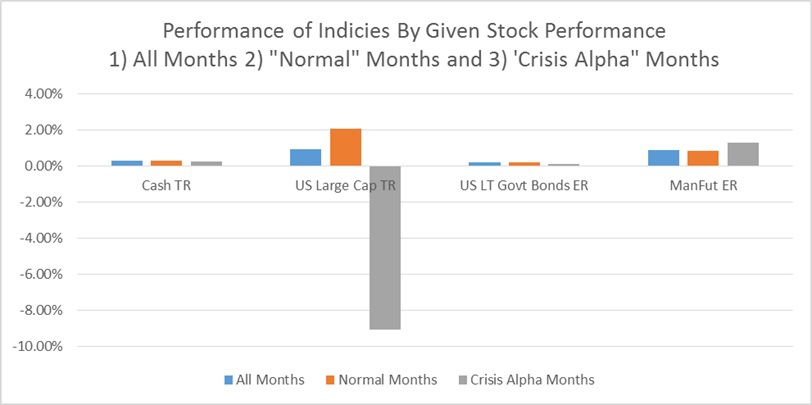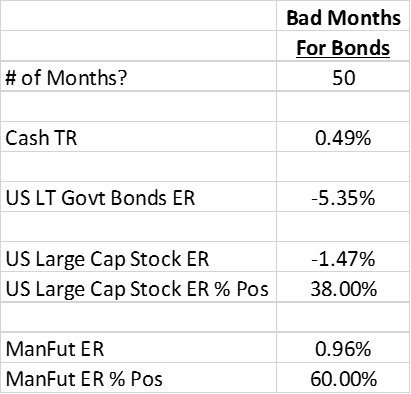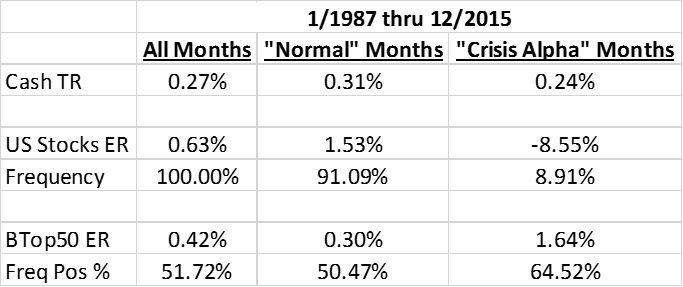In my two previous blog posts (here and here), I analyze the performance of bonds during really bad months for US stocks (“Crisis Alpha” months), and I analyze the performance of US stocks during really bad months for US bonds. A quick summary of the results from those prior studies:
- Bonds have historically provided some diversification benefit during bad months for stocks. Bonds have historically had a positive return in excess of cash of about 0.12%, on average. The excess return has historically been positive about 55% of the time. However, most of that performance has been driven by the income return component of bonds, and not their price appreciation. This might make future diversification benefits harder to come by for bonds.
- Stocks have historically provided “meh” diversification benefit for bonds when bond returns have been bad. Stocks, historically and on average, have provided negative returns in excess of cash during the worst 50 months for bonds. In addition, stocks have provided positive returns in excess of cash only about 40% of the time.
One key takeaway point from the previous posts is that investors may need to look beyond traditional stock/bond portfolios in an attempt to increase the diversification of their portfolios. Among the more compelling “outside the box” diversification options are managed futures, which Wes briefly mentions in an older post here on crisis alpha.
What in the heck are managed futures?
Managed futures is a catch-all term for strategies that trade futures contracts. In many respects the label “managed futures” is similar to “equity investor”–the label doesn’t really narrow things down. That being said, futures-based trading strategies have typically been pursued by hedge funds and commodity trading advisors (CTAs) and many of these strategies are based on some sort of trend-following rule(s).
Trend following (or absolute momentum investing) can be best described as going long assets that are going up in price and selling (shorting) assets that are declining in price. The managers of managed future strategies apply this trend following investing on many (thirty or more) liquid and exchange traded future contracts across commodities, equity indices, currencies and government bonds.
To learn more about Managed Futures, please check out the following links:
- CME Group Education Center
- In Search of Crisis Alpha by Dr. Kathyrn Kaminski
- Trend Following with Managed Futures
- Managed Futures Category Handbook by Morningstar
- A Century of Trend-Following Investing
How do Managed Futures Work in a Portfolio?
Data
For the time period 1/1926 through 12/2012, we use Ibbotson Associates US Large Cap TR index for US Stocks, Ibbotson Associates Long-Term US Government Bond TR index for US Bonds, Ibbotson Associates 30 Day T-Bill TR for Cash and the data from the AQR paper “A Century of Evidence on Trend-Following Investing” net of the paper’s estimate of fees and transaction costs (which are estimated net excess returns) for the Managed Futures return stream. We do an additional robustness check with additional data, as described below.
To extend the analysis on Managed Futures, we also use the Barclays Top 50 Index (BTop50) which is a net of fees index created by Barclays Hedge, Ltd. to represent the Managed Futures industry. It is not possible to invest in the index, but in order for a manager to be included in the index they must be open to new investments (among several other requirements). The Barclays Top 50 index is used as a proxy for net of fee, live and out of sample performance of the Managed Futures strategy. The BTop50 has data going back to 1987.
Unless otherwise noted, all returns will be excess returns (total returns less the return on cash) and all averages are arithmetic.
Correlations
First, to determine if a Managed Futures allocation might diversify a portfolio of traditional stocks and bonds we use the traditional tool, correlation analysis. The results are as follows:

The results are hypothetical results and are NOT an indicator of future results and do NOT represent returns that any investor actually attained. Indexes are unmanaged, do not reflect management or trading fees, and one cannot invest directly in an index. Additional information regarding the construction of these results is available upon request.
The correlation table, above, shows that US Stocks and US bonds have had very little correlation with one another over time (as expected). In addition, Managed Futures (ManFut) shows very little correlation to US Stocks and US Bonds. This indicates that they have the potential to be a great diversifier to a portfolio of US Stocks and US Bonds.
However, as the two previous blog posts have shown, one must also look past summary correlations and also look at how assets have performed during “crisis” periods in order to determine if the diversification is helpful (i.e., the returns aren’t all bad at the same time) or if it is pseudo-diversification (i.e., the cross correlations are low but the returns are bad at the same time).
Performance When Stock Returns Are Bad (“Crisis Alpha” months)
As in my previous blog post, we will divide history into two categories 1) US stock total returns are -5% or worse (“Crisis Alpha” months) and 2) US Stock total returns are greater than -5% (“Normal” months). We will then study the historical returns of US Stocks, US Bonds, Cash and Managed Futures during those time periods. I have summarized the return data in the table below:

The results are hypothetical results and are NOT an indicator of future results and do NOT represent returns that any investor actually attained. Indexes are unmanaged, do not reflect management or trading fees, and one cannot invest directly in an index. Additional information regarding the construction of these results is available upon request.
And a visual summary of the data:

The results are hypothetical results and are NOT an indicator of future results and do NOT represent returns that any investor actually attained. Indexes are unmanaged, do not reflect management or trading fees, and one cannot invest directly in an index. Additional information regarding the construction of these results is available upon request.
As you can see from the table and graphs, most of the time (90%) US stocks have had total returns that were greater than -5% in a month. During those 90% of months, US stocks averaged total returns of 2.08%. However, during “Crisis Alpha” months, stocks have averaged total returns of -9.05%.
In order to provide attractive diversification for stocks, an investment doesn’t only need to have low correlation, but it must deliver attractive returns (on average) during those “Crisis Alpha” months…and do so with some consistency.
As we look at the performance of US Bonds, we see that they did in fact provide positive excess returns, on average, of 0.12% and did so with some consistency (positive excess returns in 55% of “Crisis Alpha” months).
However, given the difference in magnitude between US stock returns during “Crisis Alpha” months (-9.05% total return) and US bond returns (0.12% excess return), it is a drop in (the diversification) bucket.
As we study the Managed Future return series during “Crisis Alpha” months we see that it has provided an excess return of 1.30%, which is more than 10X the performance of bonds during “Crisis Alpha” months! In addition, the Managed Futures return series has provided positive excess returns in “Crisis Alpha” months 67% of the time.
So to summarize so far – Bonds have been an OK diversifier for stocks (low correlation and small positive excess returns during “Crisis Alpha” months), but Managed Futures have the potential for offering much better diversification (low correlation with larger and more consistent positive excess returns during “Crisis Alpha” months).
This finding isn’t new, but confirms the findings of researchers like Dr. Kathyrn Kamisky and Dr. Alex Greyserman that managed futures tend to provide positive excess returns during periods when US stocks perform unusually poorly.
Performance when Bond Returns Are Bad
To analyze the performance of how US stocks and Managed Futures perform during bad months for bonds, we look at the 50 worst months of excess returns for bonds over the period 1/1926 through 12/1926. A summary table of the data is below:

The results are hypothetical results and are NOT an indicator of future results and do NOT represent returns that any investor actually attained. Indexes are unmanaged, do not reflect management or trading fees, and one cannot invest directly in an index. Additional information regarding the construction of these results is available upon request.
And visually:

The results are hypothetical results and are NOT an indicator of future results and do NOT represent returns that any investor actually attained. Indexes are unmanaged, do not reflect management or trading fees, and one cannot invest directly in an index. Additional information regarding the construction of these results is available upon request.
As you can see from the data, above, US Bonds have historically averaged a -5.35% excess return during their 50 worst months. During these tough months for US bonds, US stocks have also struggled with an average excess return of -1.47%. In addition, during the 50 worst months for US bonds, US stocks have only generated a positive excess return in 38% of those months.
Said another way – when US bonds struggle, US stocks haven’t historically provided much help for portfolios.
As we look at the performance of Managed Futures (ManFut) during the 50 worst months for US bonds, however, we see that they have averaged a 0.96% excess return. In addition, Managed Futures have generated a positive excess return in 30 of the 50 worst months for bonds.
This finding seems to be a less discussed attribute of Managed Futures – they are an investment (or investment strategy) that has historically provided a positive long-term return and also provides diversification for both US stocks AND US bonds.
Robustness Check
There is always a chance that the findings discussed above are due to chance or data mining or other issues that might make the Managed Futures strategy appear more attractive. To help address that concern, we do a robustness check on the findings by using the Barclays Top 50 Index (BTop50) and repeating the analysis using data from 1/1987 through 12/2015.
For US stocks the data table is below:

The results are hypothetical results and are NOT an indicator of future results and do NOT represent returns that any investor actually attained. Indexes are unmanaged, do not reflect management or trading fees, and one cannot invest directly in an index. Additional information regarding the construction of these results is available upon request.
As you can see in the graph, US stocks since 1987 have about the same ratio of “Normal” months at about 90% and “Crisis Alpha” months at about 10% as they do in the longer data sample (1/1926 through 12/2012). In addition, the returns during “Normal” months is very similar at a positive 1.53% excess return and the return during “Crisis Alpha” months is also very similar to the longer sample at -8.55%.
As we look at the Btop50 excess return performance since 1/1987 we can see some items that are different from the AQR data and some consistencies:
I notice two main differences between the BTop50 performance and the AQR performance:
- Frequency of positive excess returns – The AQR data shows that excess returns are positive about 66% of the time. However, the BTop50 shows that excess returns are positive only about 52% of the time. These are obviously over different time periods, but it shows that perhaps some of the returns from the Managed Futures strategy have been eroded away.
- Average Returns are less during All Months and “Normal” Months – The notion that returns are less for the Managed Futures strategy is further supported by the data in that the average excess return during all months is about 0.4% less in the BTop50 data than it is in the AQR data. In addition, the returns during “Normal” times is also about 0.4% less in the BTop50 data than in the AQR data.
Despite the differences, one striking and very important similarity remains:
- Returns during “Crisis Alpha” months – The average excess return during “Crisis Alpha” months is 1.64% which is about the same as the excess return in the AQR data (although over different time periods). In addition, the frequency of positive excess returns is about the same in the BTop50 data (about 65%) as in the AQR data (about 67%).
This robustness check on Managed Futures helps strengthen the case that Managed Futures are capable of delivering attractive diversification benefits for stocks.
For the 50 worst months for US Bonds since 1/1987, the data table is below:

The results are hypothetical results and are NOT an indicator of future results and do NOT represent returns that any investor actually attained. Indexes are unmanaged, do not reflect management or trading fees, and one cannot invest directly in an index. Additional information regarding the construction of these results is available upon request.
As we can see from the table, above, US bonds have averaged an excess return of about -4% during their worst 50 months between 1/1987 and 12/2015. This is largely consistent with the performance during the worst 50 months for bonds between 1/1926 and 12/2012.
One notable difference between the AQR data and the BTop50 data is that the BTop50 hasn’t provided a positive excess return during bad months for bonds. There could be any number of reasons for this and it might be the subject of a future blog post.
A Poor Man’s Method to Attain Managed Futures Exposure?
Ok, enough with the theory…how do you add Managed Futures exposure to your portfolio? There are a couple of choices in varying degrees of complexity, fees, etc. I’d revisit Wes’s great article on FACTS to determine where you feel most comfortable in the spectrum of the FACTS framework.
- Option 1 – Direct exposure to CTA hedge funds: This might be the route preferred by most institutional investors, but this isn’t an option for most individual investors.
- Option 2 – Invest in a mutual fund that uses a Managed Futures strategy: There has been a large increase in the offering of mutual funds that pursue a managed futures strategy. However, there can be added complexity due to choices about how the fund is managed (does it invest directly or is it pursuing a fund of funds type strategy, etc.)
- Option 3 – Replicate a Managed Futures type strategy in your own portfolio: One could identify a group of ETFs that approximate exposures available via futures (e.g., equity, fixed income, commodities, and FX) and run a simple trend-following model to determine long/short exposures. If the short side is too complicated, a long/flat (go long or go to cash, but never short) approach could potentially work (see the RAA system for an example). The DIY approach is potentially cheaper, but one also risks diluting the performance of a more pure managed futures exposure.
Summary
Studying bond returns during tough times for stocks (and vice versa) shows that correlation might overstate the diversification benefits of stocks and bonds. This post introduces a new investment strategy, Managed Futures, and shows that Managed Futures have promising diversification benefits for stocks AND bonds using one data set.
Using another data set for the Managed Futures strategy shows that Managed Futures have been a great diversifier for stocks but a mixed bag diversifier for bonds.
Hopefully, this post serves as a good starting point in understanding some of the diversification benefits Managed Futures may provide.
About the Author: Andrew Miller
—
Important Disclosures
For informational and educational purposes only and should not be construed as specific investment, accounting, legal, or tax advice. Certain information is deemed to be reliable, but its accuracy and completeness cannot be guaranteed. Third party information may become outdated or otherwise superseded without notice. Neither the Securities and Exchange Commission (SEC) nor any other federal or state agency has approved, determined the accuracy, or confirmed the adequacy of this article.
The views and opinions expressed herein are those of the author and do not necessarily reflect the views of Alpha Architect, its affiliates or its employees. Our full disclosures are available here. Definitions of common statistics used in our analysis are available here (towards the bottom).
Join thousands of other readers and subscribe to our blog.

